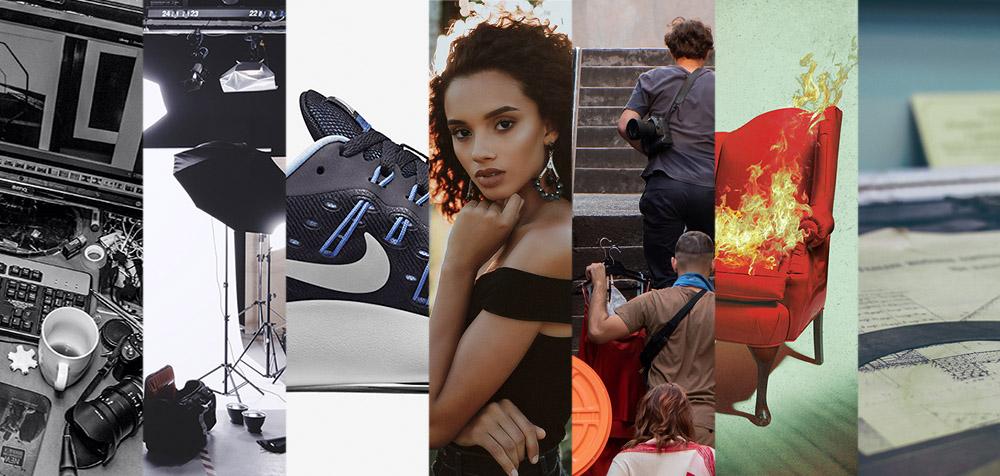It might come as a surprise that, just as there are different types of retouching, there are also a whole lot of different types of retouchers. Just think about all the different types of images out there and try to imagine who's behind that work.
Planning which type of retoucher you want to be requires understanding a little about the landscape of retouching. The following is by no means exhaustive, but it’s a good bird’s-eye view of the industry.
Photo by One Zone Studio
The Photo Studio Digitech-Retoucher
Sounds pretty high tech, right? If you're trained as a photographer and know your way around retouching too, a role like this is great. It's a hybrid position where the Digitech-Retoucher is not only photo editing but helping make the photo itself.
Digitech traditionally is a role on-set at a photoshoot, doing a wide variety of stuff except retouching. But for a photographer, a 2-for-1 Digitech-Retoucher can be a huge value. They'll be tech-ing while looking out for photo assets they'll need to do the retouching later.

Photo by Alexander Dummer
The Production Retoucher
This retoucher starts out as a generalist, often a graphic designer with a knack for retouching. They may be using a lot of different software: indesign, illustrator, photoshop. For the Production Retoucher, the focus should be to work as much in Photoshop as possible, and end up the go-to gal for retouching.
You'll know all the other programs, but being the retouching whiz can segue into the title of "Retoucher" later on.
Important note: Production Retouchers, though they may be creative people, begin as technical types. They understand the image pipeline, and provide the rare service of making sure images look good and meet technical specs.

Photo by Unruh/Jones Retouching by Me
The Creative Retoucher
Creative retouching is probably what most of us think of when we're starting out. The creative retoucher in an agency or studio has put in a lot of time to reach that spot. Paying clients require a pretty high level of confidence and credentials to grant a retoucher free reign to be part of creative decisions.
For many Creative Retouchers, I observe them operating as Creative Retoucher/Photographers, producing their own photos to retouch creatively. The solo creative retoucher is often doing a ton of styling in camera and major color grading in post.
They make money selling prints, speaking at conferences, and finding sponsorships as their career grows. If they have the right voice and get in front of the right eyes, they might land commercial clients and cross over into agency or brand service.

Creative compositing by Me
Beauty and Fashion Retouchers
I'll focus on this type of retouching the least because I have the least experience in it, and it's the type that's been most written about. Getting really good at skin retouching is obvious, but I do have insight about business that might help.
One student of mine who positioned himself as a beauty and portrait retouching guy asked advice about getting more work. He was testing with local modeling agencies’ newer models to build their books. It's a common practice.
His shots were nice, but his portfolio voice was all over the place. Each image had a different vibe. When I asked what kinds of clients he was targeting, it sounded like he was focusing on building his portfolio without really using a client as his avatar.
I felt like this was backwards. And hard. I told him to research the creative agencies in his nearest city who handle brands he’d like to work with. Study their brand voice. Then go back to the modeling agency with a mood board based on research.
Working with the agency rep, find a model who's a good fit, and shoot a campaign of 3 to 5 images that match the brand voice. Now do everything you can to connect with the creative agency and get it in front of the right person.
If you build a beauty, fashion, or portrait book in this way you'll be far more commercially viable.

The Intern or Assistant
Did you know that many internships are paid these days? Sounds cliche, but it's the best way to get a foot in the door. The benefit of this role is mentorship. The Intern isn't going to get paid a lot, but the training is priceless.
Focus on learning as much about the technical basics of retouching as possible, don't focus too much on creativity. When you're starting, nobody pays you to be a creative butterfly. They will however pay you to prep files really well. You might be allowed to do a little color work but focus on getting good at the very basics.
This often leads to an assistant role where you'll make a real salary and get paid to learn. That’s when you’ll step into a little more color correction and slightly more creative retouching.
With this knowledge and a good foundation in photo retouching, it's time to knock on doors.
Photo by Mitchell Luo
Sef's Get-A-Client-ASAP Blueprint
Prerequisite: update your LinkedIn profile and your portfolio. Once you define a target client (re: my student example above), update your portfolio to speak their voice before contacting them.
- Google up "creative agencies in (your nearest city here)" This could also be "photography studio in..." Clutch.co tends to come up as a top result in the US.
- Choose one and visit their website, learn about their clients and style
- Find them on LinkedIn and click People
- Look for the people who might make decisions about hiring retouchers, these people generally are producers or project managers.
- In smaller agencies they could also be: art or creative directors, account managers, graphic designers, or even the ECD or Founder.
- Pick one of these folks and message them on LinkedIn.
Finally, remember people check LinkedIn intermittently, wait a week and check back. Don't be salesy, write like a human. You're checking in because you like their work, and are a retoucher.
Put your email address, and link to your portfolio (with the targeted work you created for them!)

Photo by Sergey Zolkin
Don’t Wait Until Everything Is Perfect, Start Planting Now
If you regularly spend a day planting seeds like this, something is sure to sprout up. Just being on a producer's mind is where you want to be. When that next unexpected project drops on their desk and their regular retoucher is booked, they'll call you.
I really hope you walk away from this article with a little added confidence that you have a better handle on the different types of retouching and the retouchers who make it happen, and that you’ve got a simple linear workflow to use to land some commercial retouching clients.

90 Days Of Content
Over the next 90 days we are going to be working with some top artists to explore recommendations giving you solutions to problems we have all gone through. We are paying the writers a really fair wage for every original article, and we are writing about things that aren’t sponsored by any brand. There is no one but our opinion behind it. We would love it if you do use our affiliate links here so we can continue to keep writing awesome articles that you can trust.











